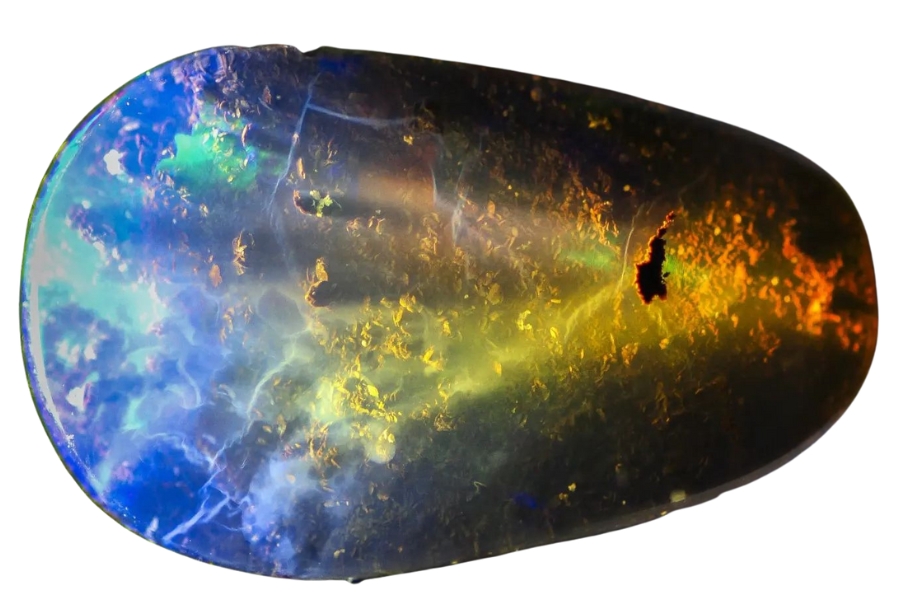Opals, the captivating gemstones known for their mesmerizing play of colors, are not just distant treasures hidden in faraway lands.
In the heart of the Pacific Northwest, Washington State holds a secret that many may not be aware of – its opal deposits. The state’s opal occurrences are a testament to the natural beauty and geological diversity of the region.
These gems, with their iridescent hues and unique formations, offer an exciting opportunity for rockhounds and gem enthusiasts alike to explore the hidden treasures beneath the Evergreen State’s surface.
This article will detail the fascinating world of opals and where you can find them in Washington. Come with us on this trip as we explore the Evergreen State’s beautiful scenery and learn the art of opal hunting!
What Is Washington Opal Anyway?

Opals are beautiful gems that are known for the way their colors play off of each other, making them look like a fascinating dance of light and color.
The tiny silica spheres that make up these beautiful gems are grouped in a very precise and orderly way. Opals are truly unique because they can bend light, creating a range of colors that change depending on how you look at them.
This effect on light is called “opalescence,” and it’s what makes opals so beautiful and eye-catching. Opals usually grow in the cracks and holes of ancient rocks like shale and sandstone.
Opals can be found all over the world, but Washington state is proud to have its own opal deposits. An opal’s worth may differ according on the location of discovery.
This guide will teach you how to find and identify opals faster, which will help you in your search.
The Types Of Opal Found In The US
There are several incredible types of Opal that can be found in the US as well as in our state. Each is uniquely beautiful and interesting including:

Common Opal
Common opal, also known as “potch,” stands out from other types of opal due to its lack of play-of-color, the iridescent display seen in precious opal. Instead, common opal features consistent, solid colors like white, pink, yellow, green, and blue.
It typically has a waxy to pearly luster and ranges from opaque to translucent. To identify common opal, look for its uniform color and absence of the shimmering color flashes found in precious opal.
Common opal forms under similar geological conditions as other opals, where silica-rich water seeps into rock cavities and slowly hardens over time. This process usually occurs in areas with volcanic activity or hot springs, where silica deposits are prevalent.

Fire Opal
Fire opal is known for its warm, vibrant colors, ranging from yellow and orange to deep red. Unlike precious opal, fire opal may or may not display the play-of-color, but its fiery body color makes it unique.
To identify fire opal, look for its bright, translucent to transparent appearance and the absence or presence of play-of-color within the warm hues.
Fire opal forms in volcanic regions where water rich in silica interacts with hot lava, filling cavities and fractures within the rock. Over time, the silica solution hardens, creating opal.
Visually, fire opal’s appeal lies in its vivid, flame-like colors that can be either uniform or exhibit internal flashes of color.

Boulder Opal
Boulder opal forms within the ironstone boulders of its host rock. Unlike other opals, boulder opal features precious opal veins intertwined with the natural rock, creating a beautiful contrast.
This opal is distinguished by its combination of colorful opal patches and the surrounding matrix, which can include ironstone or sandstone. To identify boulder opal, look for its vibrant play-of-color within the darker host rock, often showcasing brilliant blues, greens, and reds.
Boulder opal forms in sedimentary environments where silica-rich water infiltrates cracks and voids within ironstone or sandstone boulders. Over time, the silica hardens into opal, often creating thin seams or patches within the rock.

Hyalite Opal
Hyalite opal, also known as water opal, is a transparent to translucent type of opal that is distinctive for its glass-like appearance and lack of play-of-color. Unlike precious opal, which displays a rainbow-like iridescence.
You can identify hyalite opal by its clear to milky appearance, often with a slight green or blue fluorescence under UV light.
Hyalite opal forms in low-temperature hydrothermal environments, typically in volcanic regions. It precipitates from silica-rich fluids that fill cracks and voids in the host rock. This process can occur relatively quickly compared to other opal types.
Visually, hyalite opal resembles droplets of water or glass, often appearing as smooth, botryoidal (grape-like) formations. Its transparent nature makes it unique among opals, and its slight fluorescence adds to its allure.

Black Opal
Black opal is a rare and highly prized variety known for its dark body tone, which enhances the vibrant play-of-color. Unlike other opals, black opal has a deep background color, ranging from dark gray to jet black, making the iridescent colors more striking.
To identify black opal, look for its intense, dark base color coupled with brilliant flashes of blues, greens, reds, and other hues.
The presence of iron and carbon contributes to its dark body color. In the United States, black opal is primarily found in the Virgin Valley of Nevada, known for its rich opal deposits.

Crystal Opal
Crystal opal is known for its transparent to translucent body, which allows the play-of-color to shine through brilliantly. Unlike common opal, which is opaque, crystal opal’s clear or semi-clear nature enhances its vibrant internal colors.
To identify crystal opal, look for its see-through quality combined with flashes of color that can include blues, greens, reds, and more.
Its unique transparency sets crystal opal apart, making it a favorite among gem enthusiasts and collectors for its ethereal beauty.
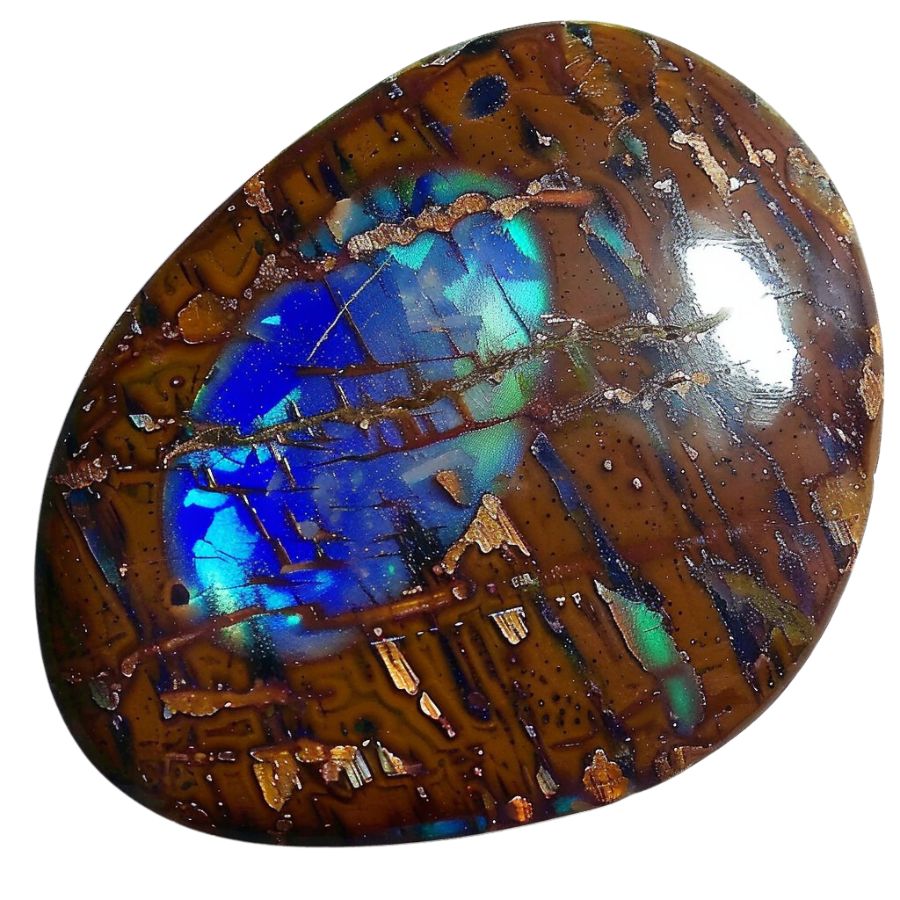
Wood Opal (Opalized Wood)
Opalized wood is a fascinating form of petrified wood where the organic material has been replaced by opal. Unlike other opals, opalized wood retains the original structure and texture of the wood, creating a unique blend of organic and mineral elements.
To identify opalized wood, look for its wood grain patterns and opalescent sheen, often displaying a range of colors from white and brown to vibrant reds and greens.
Opalized wood forms under specific conditions where wood is buried in silica-rich sediment. Over millions of years, the silica solution gradually replaces the organic wood material with opal, preserving the wood’s original structure in stunning detail.

Contra Luz Opal
Contra Luz opal reveals its vibrant play-of-color when illuminated from behind. Unlike other opals, which display their colors through surface reflection, contra luz opal’s brilliance comes to life with transmitted light.
To identify contra luz opal, hold the gem against a light source and observe the internal flashes of color, which can include vivid reds, blues, greens, and purples.
This opal forms in volcanic environments where silica-rich water infiltrates cracks and cavities in the host rock. As the water evaporates, it leaves behind silica deposits that eventually solidify into opal.
Visually, contra luz opal appears nearly clear or milky when viewed without backlighting. However, when backlit, it displays stunning, colorful patterns that seem to glow from within.
What Rough Opal Looks Like
When you’re out looking for rough opal on your own it’s important to know what you’re looking for.
DON'T MISS OUT ON ANY GREAT FINDS!
While you're out searching for Geodes you're going to find a lot of other interesting rocks and minerals along the way. The last thing you want to do is toss out something really interesting or valuable. It can be easy to misidentify things without a little guidance.
We've put together a fantastic field guide that makes identifying 140 of the most interesting and valuable rocks and minerals you will find REALLY EASY. It's simple to use, really durable, and will allow you to identify just about any rock and mineral you come across. Make sure you bring it along on your hunt!
This is what you need to look out for:
Look for exteriors like this
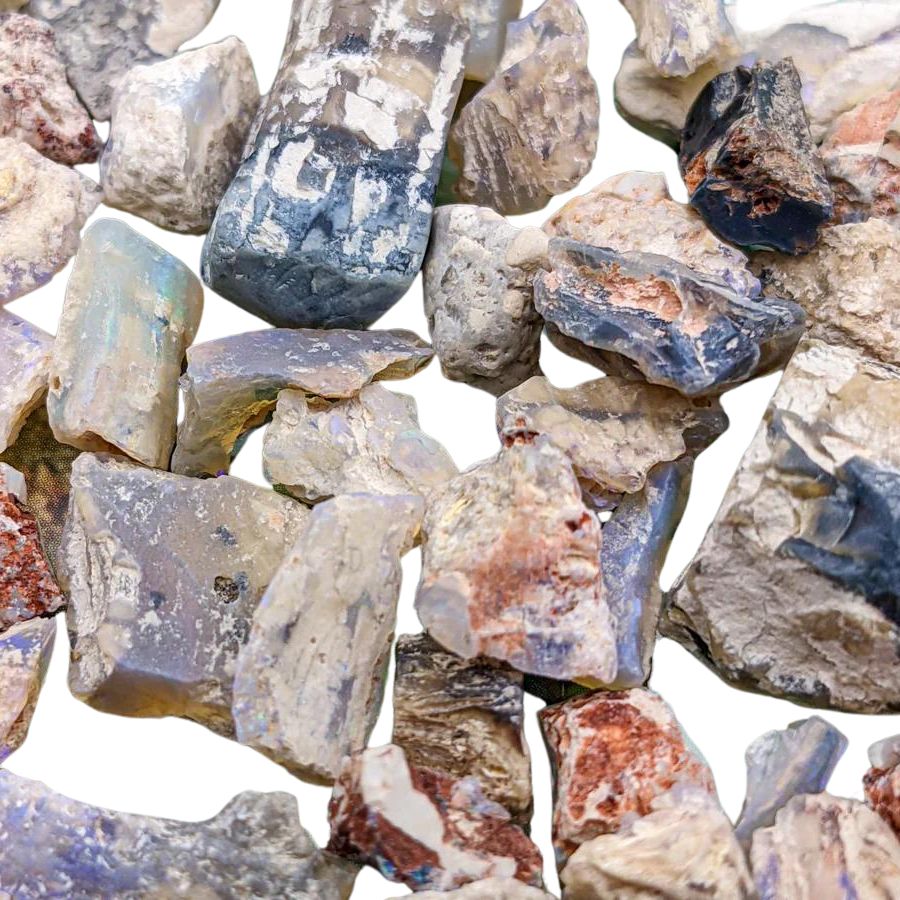
Look for play-of-color
Opal can display a range of colors, but what sets precious opal apart is its play-of-color—vivid flashes of multiple colors that change with the angle of light. Even in rough form, you might see hints of these colors peeking through.
Common opal lacks this feature and typically appears as a solid color like white, blue, or pink.
Check for a glassy or waxy luster
Opal often has a distinctive glassy or waxy luster. When you find a potential opal, examine its surface.
It should look shiny and smooth, almost like glass, even if it is still encased in a matrix or rough exterior.
Assess the density and weight
Opal is generally lighter than rocks of a similar size. When you pick up a piece of rough opal, it should feel lighter than expected.
Additionally, opal is relatively soft, with a Mohs hardness of 5.5 to 6.5, so it can be scratched more easily than quartz or other harder minerals.
A Quick Request About Collecting
Always Confirm Access and Collection Rules!
Before heading out to any of the locations on our list you need to confirm access requirements and collection rules for both public and private locations directly with the location. We haven’t personally verified every location and the access requirements and collection rules often change without notice.
Many of the locations we mention will not allow collecting but are still great places for those who love to find beautiful rocks and minerals in the wild without keeping them. We also can’t guarantee you will find anything in these locations since they are constantly changing.
Always get updated information directly from the source ahead of time to ensure responsible rockhounding. If you want even more current options it’s always a good idea to contact local rock and mineral clubs and groups
Tips on where to look
Once you get to the places we have listed below there are some things you should keep in mind when you’re searching:
Search in Sedimentary Rock Formations

Opal can also form in sedimentary rock formations where silica deposits have accumulated over time.
Focus on areas with ancient lake beds or clay deposits, as these environments are conducive to opal formation.
Check Dry Creek Beds and Gullies

Dry creek beds and gullies can be excellent places to find opal, as water flow can erode and expose opal-bearing rocks.
Look for exposed rock and gravel in these areas, especially after rainfall or seasonal flooding.
Investigate Old Mining Sites

Abandoned or historical mining sites can be rich in opal and other minerals. These areas often have tailings and discarded rock that may still contain opal.
Always seek permission if the land is privately owned and follow safety guidelines.
Look for Indicator Minerals
Certain minerals can indicate the presence of opal. Look for rocks and soil containing ironstone, sandstone, or clay, as these materials often coexist with opal deposits.
Additionally, finding quartz or chalcedony can suggest nearby opal.
- The deep experience and understanding of our team about the area
- Recommendations from local groups and clubs
- How easy it is to get the a particular location
- Safety and potential hazards when collecting
- Weighing private and public locations
- The ability for both experienced and novice geode enthusiasts to find great samples
With these factors in mind we’ve been able to put together a fantastic list that just about anyone can use!
The Best Places To Find Opal in Washington

Let’s talk about where in the state you can find opal the best. There are many places to find gems in Washington, but only a few are good for opal. Not a lot of people know about these lovely places!
Always Confirm Access and Collection Rules!
Before heading out to any of the locations on our list you need to confirm access requirements and collection rules for both public and private locations directly with the location. We haven’t personally verified every location and the access requirements and collection rules often change without notice.
Many of the locations we mention will not allow collecting but are still great places for those who love to find beautiful rocks and minerals in the wild without keeping them. We also can’t guarantee you will find anything in these locations since they are constantly changing.
Always get updated information directly from the source ahead of time to ensure responsible rockhounding. If you want even more current options it’s always a good idea to contact local rock and mineral clubs and groups
Chinook Pass
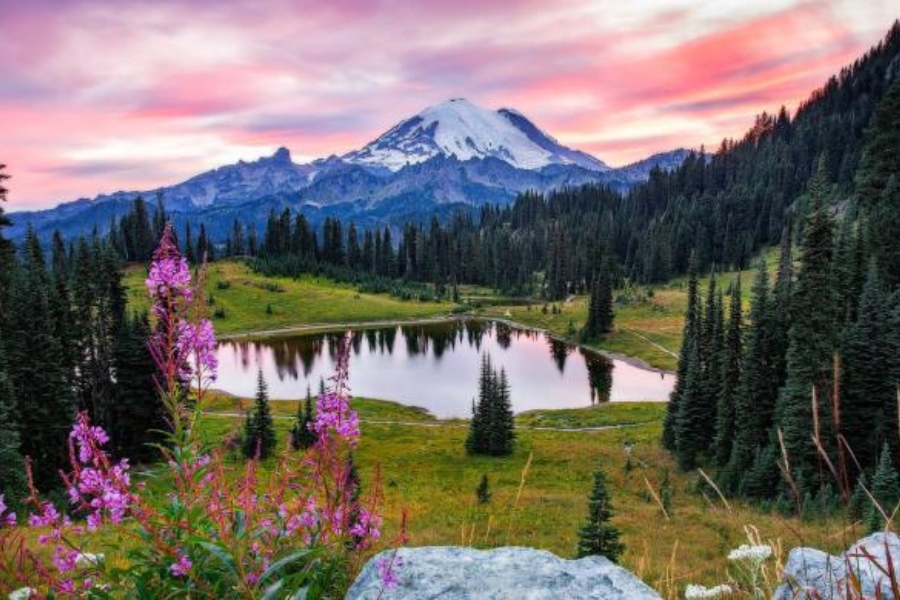
The beautiful Cascade Mountains surround Chinook Pass, making it a great place for wildlife lovers and rock climbers. With views of snow-capped peaks, lush alpine fields, and clear lakes, this beautiful mountain pass is known for its stunning scenery. But for people who want to find opals, it’s a secret gem.
Because of its geology, Chinook Pass is a great place to look for opal. The pass is in the Wenatchee National Forest’s Naches Ranger District, which is known for its many different types of rock formations.
Additionally, Chinook Pass provides many fun activities, such as hiking and camping, so people looking for opals can combine their search with an unforgettable outdoor journey.
So, whether you want to become a geologist or do something different and fun, Washington’s Chinook Pass is calling you with its geological wonders and opal-rich landscape. It promises an exciting trip through nature and gem exploration!
Ensure you know the latest rules on collecting before you bring anything back from Washington.
Where we found opal at Chinook Pass
The rough landscape, with its rocky outcrops and mineral-rich soils, is perfect for the growth of opals. The areas around Chinook Pass are full of opals of all different colors and shapes, making it a treasure trove for gem lovers.
DON'T MISS OUT ON ANY GREAT FINDS!
While you're out searching for Geodes you're going to find a lot of other interesting rocks and minerals along the way. The last thing you want to do is toss out something really interesting or valuable. It can be easy to misidentify things without a little guidance.
We've put together a fantastic field guide that makes identifying 140 of the most interesting and valuable rocks and minerals you will find REALLY EASY. It's simple to use, really durable, and will allow you to identify just about any rock and mineral you come across. Make sure you bring it along on your hunt!
Denny Mountain

The prominent peak of Denny Mountain in Washington’s Cascade Range offers an enticing chance for opal lovers to go on a treasure-hunting journey.
In the Snoqualmie National Forest, this hilly area has not only stunning views, but also a geological setting that is good for opal formation.
It’s a good place to look for opals because it has sedimentary rock layers. Soils that are high in minerals and cracks in rocks make the perfect environment for opals to grow and show their beautiful colors.
Denny Mountain calls to people who want to find the sparkling gems that lie beneath its rough surface. Anyone who loves opals and the outdoors can have a unique and satisfying experience at Denny Mountain, no matter how much experience they have hunting gems or going on adventures.
Where we found opal at Denny Mountain
The hiking paths and rocky outcrops of Denny Mountain are open to explorers and rockhounds who want to find opals in the area.
Mount Rainier National Park

Mount Rainier National Park is a beautiful natural area in the middle of Washington state. It’s famous for its tall, snow-capped top, lush forests, and many animals.
A lesser-known gem hunter’s prize lies beneath this beautiful landscape: the chance to find opals. The majestic beauty of Mount Rainier is what draws people there, but the park’s natural features also make it an exciting place to look for opals.
People who love geology and the great outdoors will enjoy the thrill of finding opals in the park’s pristine wildness.
As a result, Mount Rainier National Park is a great place to go opal hunting, whether you’re a severe gem hunter or want to mix treasure hunting with enjoying nature.
Where we found opal at Mount Rainier National Park
Different types of rocks in Mount Rainier National Park, like volcanic rocks and mineral-rich soils, make it a good place for opals to form. You can look for these beautiful gems on the park’s paths, in the creek beds, and on the rocky ground.
Saddle Mountain

Saddle Mountain, a famous peak in the state, is a great place for opal hunters to start a treasure hunters’ adventure. Located in the Wenatchee National Forest, this hilly area not only has stunning views but also is a great place for opals to grow.
Mineral-rich soils and sedimentary rock layers make up Saddle Mountain’s geology, which makes it a good place to look for opals. The presence of cracks and pockets in the rocks makes it even more likely that these beautiful jewels will be found.
Coming across opals in the wild, untouched Wenatchee National Forest adds an extra layer of excitement to the trip. Saddle Mountain invites you to explore its geological wonders and find the iridescent gems hidden in its beautiful scenery.
For those who look for it, this one-of-a-kind mix of natural beauty and opal-rich possibility will be an unforgettable experience!
Where we found opal at Saddle Mountain
People who like to explore and find rocks can use Saddle Mountain’s hiking trails and rocky areas to look for opals hidden beneath its rough surface.
Washington Pass

Washington Pass is in the rough North Cascades of the state. Its beautiful scenery tempts explorers and rockhounds with the promise of opal-rich landscapes.
Along the North Cascades Highway, this famous mountain pass not only has great views of tall mountains, but it also hides natural gems.
The adventure is already exhilarating, but finding opals in the wild North Cascades adds another level of excitement. Washington Pass is a one-of-a-kind place to mix the beauty of nature with the search for opal treasures.
Those who go on this opal-hunting adventure will have an unforgettable and rewarding experience.
Where we found opal at Washington Pass
People who like rocks and wildlife can look for opals in the rough terrain, hiking trails, and creek beds near Washington Pass.
Other Great Places To Find Washington Opal

You should always keep an eye out for opals, whether hiking in the mountains or exploring the valleys. Here are more places your search might pay off, listed by county.
Our recommendations by county
| County | Location |
| Clark | Livingston Quarry |
| Douglas | Rock Island Dam |
| Douglas | Waterville area gravel pits and excavations |
| Grant | Quincy area diatomaceous earth deposits |
| King | Denny Gulch |
| Lincoln | Mondovi area lava outcrops |
| Skagit | Mount Vernon Mine |
| Whitman | Pullman area lava outcrops |
Common Opal-Hunting Questions

People often ask these things when they want to know where to find opal in Washington State:
Is it illegal to collect opal in Washington?
In Washington, it’s usually okay to collect opals for your use, but there may have been rules or restrictions based on the area and the land management agency in charge.
Opal collecting is usually governed by rules set by the federal, state, or local government. These rules can differ if you are collecting on private property or public places like national forests.
The Best Places To Buy Opal In Washington
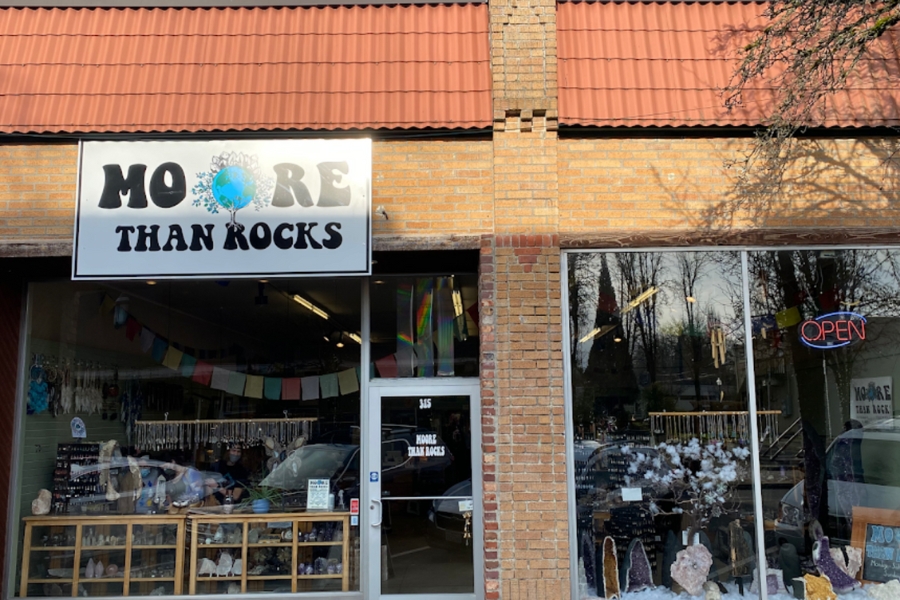
Some people don’t like going outside to look for opal because they have to work hard and get dirty. If you don’t want to do that, this list is for you.
Here are some of the best places to find and buy opal in the state:
- Cove Crystals and Gifts – 510 SE Old Arcadia Rd, Shelton, WA 98584, United States
- Jerry’s Rock & Gem – 804 W Valley Hwy, Kent, WA 98032, United States
- Moore Than Rocks – 315 W Meeker St, Kent, WA 98032, United States
- NW Rockhounds – 2720 NE 115th St, Seattle, WA 98125, United States
- Wild Earth Rocks – 11607 State Route 302 NW, Suite B, Gig Harbor, WA 98329, United States

